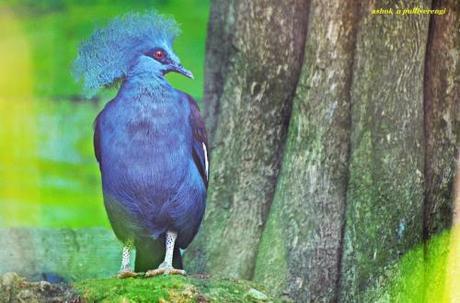Goura victoria
 Pic taken by Ashok N Pulliyerengi, in Enga Province, Papua New Guinea (Project Noah)
Pic taken by Ashok N Pulliyerengi, in Enga Province, Papua New Guinea (Project Noah)
The Victoria crowned pigeon (Goura victoria), named after Queen Victoria, is a large, bluish-grey pigeon with elegant blue lace-like crests, maroon breast and red iris.
One of three unique very large, ground-dwelling pigeons native to the New Guinea region, the Victoria crowned is the largest, at 29 to 30 inches long and weighing 5.3 lbs, and is considered the largest surviving species of pigeon in the world.
Like other crowned pigeons, the Victoria crowned pigeon is a gregarious species. They usually travel in pairs or small parties as they search for food, walking with an unhurried gait along the forest floor. Their food typically consists of fallen fruit, supplemented by seeds and invertebrates. In captivity, these pigeons are particularly fond of eating figs.
Breeding peaks late in wet season and in the dry season. When the male displays for the female, he lowers his head down, stretches forward and then rhythmically swings his head up and down while simultaneously wagging his fanned tail. Although the female does most direct brooding, both parents help raise the young. The female usually lays a single white egg in a well-built tree nest of stems, sticks and palm leaves. In the weeks before she lays the egg, the male brings nesting material to the female. The egg is incubated for around 30 days. The parents tend their baby for a total of 13 weeks before the young fledgling leaves the nest.
The Victoria crowned pigeon is now the most rarely occurring of the three crowned pigeon species in the wild, although it is the most widely kept species in captivity. This species is threatened by habitat loss due to logging, and is heavily hunted for its plumes and meat. Trapping of these pigeons to be kept alive for captive collections is now illegal but is still likely to be occurring.
The Victoria crowned pigeon is evaluated as “vulnerable” on the IUCN Red List of Threatened Species.
~Eowyn

